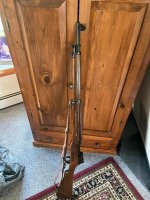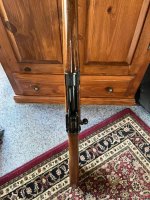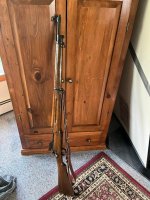I have a beautiful 1917 Enfield that I rescued in about 1975 from a LGS. The stocks were black with oil and sweated oil when fired. Handguards were cracked.
So I bought 2 surplus stocks from Ruvel and handguards. I made 1 full military stock, and cut one to be a drop in sporter.
Finished them both with about 25 coats of hand rubbed tung oil. It has not been fired since about 76. The metal is outstanding!
What is it worth?
So I bought 2 surplus stocks from Ruvel and handguards. I made 1 full military stock, and cut one to be a drop in sporter.
Finished them both with about 25 coats of hand rubbed tung oil. It has not been fired since about 76. The metal is outstanding!
What is it worth?




